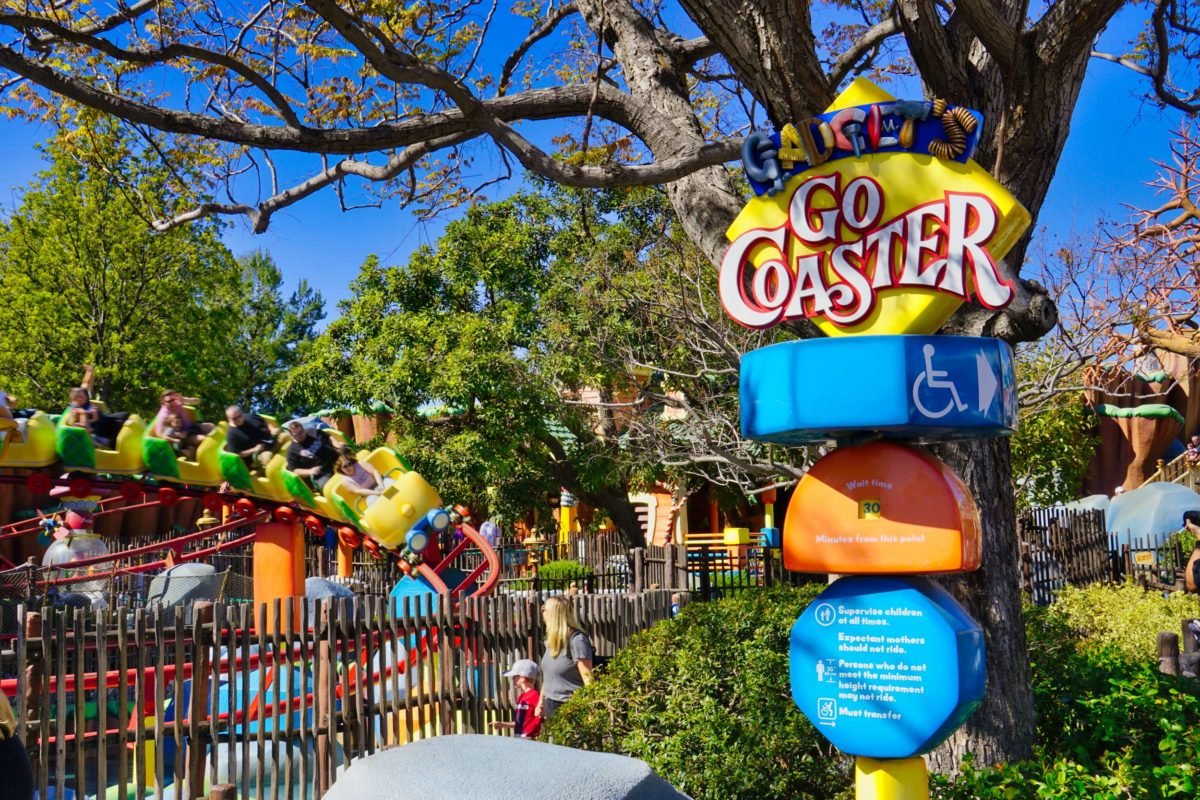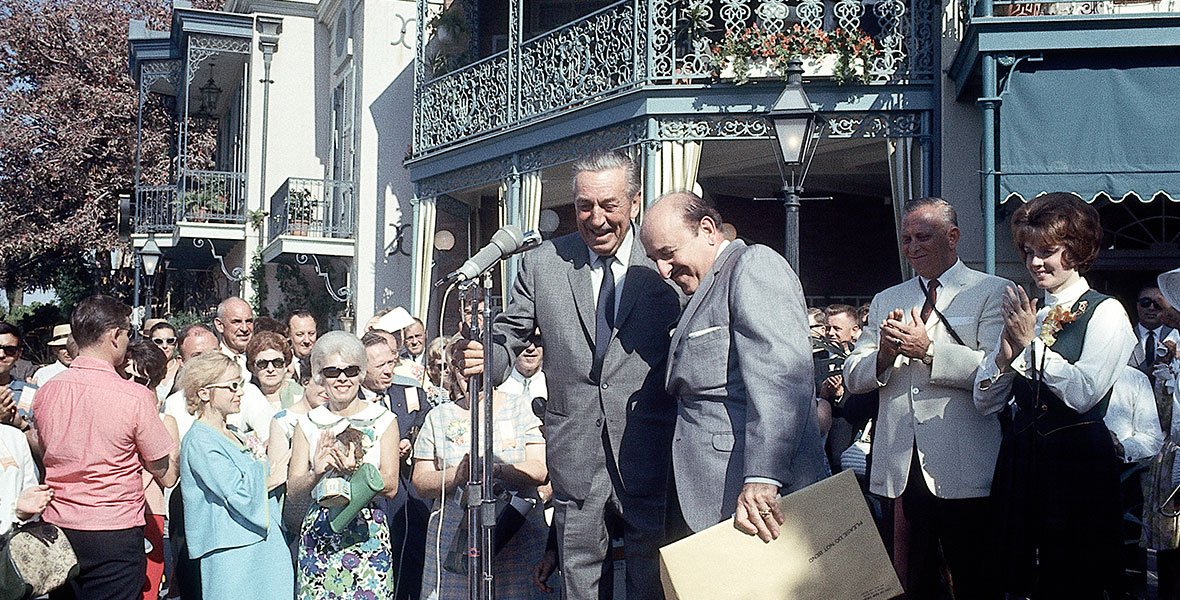The History of Mickey's ToonTown
Many of Disneyland California’s lands have occupied their current spaces for decades, some of which have remained the same over the course of many years. Prior to the 1970s, many of Disneyland’s attractions were steered toward family-friendly, tame rides that anyone of any age could enjoy. This was evident through the construction of the Rainbow Caverns Mine Train in 1956, and how it became less and less popular until it was converted into Big Thunder Mountain in 1979. The demand for thrill rides was high, which also lead to the opening of Space Mountain, Indiana Jones, and Splash Mountain. Despite these crowd-pleasing changes, yet another demand came through the pipeline, which was a dedicated area for families to meet Mickey Mouse. This idea started to come to fruition in the late 1980s.
Mickey’s ToonTown sign. Image from: https://knowyourmeme.com/photos/1207039-hollywood-sign-parodies
The Idea for mickey’s toontown
Mickey’s birthdayland
On June 18, 1988, Walt Disney World opened up a temporary land to celebrate Mickey Mouse’s 60th birthday, called Mickey’s Birthdayland. It would live where Fantasyland lives in the Magic Kingdom now, with a grand celebratory opening with first lady Nancy Reagan in attendance. The design for the area would be inspired by Duckberg from the cartoon television series DuckTales. The land would serve primarily as a meet and greet area for guests to meet Mickey and his friends, visit his home, and see his backyard where Minnie would be waiting to throw a surprise party for him. Guests could also see animals in the area too, at Grandma’s Duck Farm. Miniature horses, ducks, chickens, goats and more could be pet and be a photo opportunity.
Mickey’s Birthdayland Show. Image from: https://www.retrowdw.com/pictorial-souvenir/wdw-magic-kingdom/mickeys-birthdayland-gallery/#gallery/9a4368486fb48edcc05849623d5679ef/10884
mickey’s starland
Mickey’s Birthdayland closed in April 1990, and was converted into Mickey’s Starland just a month later. Around the same time, Mickey’s Magical TV World opened in that area of the park, and it was a stage show that featured Disney’s Afternoon Avenue characters. Mickey’s Starland continued to operate until 1995 when it was renamed once again to Mickey’s Toyland, and was rebranded one final time to Mickey’s ToonTown Fair in June 1996.
Mickey’s Starland. Image from: https://www.ebay.com/itm/275403587848
mickey ville in tokyo disneyland
Another concept was being thrown around the table for Tokyo Disneyland, with a design done by Hani El Masri for Mickey Ville. Mickey Ville was never realized, but it was an early indication that ToonTown would soon be on the way for Disneyland. El Masri’s plans included a medieval theme for the land, drawing inspiration from The Brave Little Tailor and Mickey and the Beanstalk. It would only have one attraction, which was a leisurely boat ride around the land. Similarly to ToonTown, guests could walk into some of the characters’ homes, like Donald Duck’s house boat. There would be some shopping opportunities, like in Mickey’s Music Store and Minnie’s Candy House. A version of the Main Street USA Cinema would also live here, but just simply be Mickey’s Theatre, where his old cartoons would play. Mickey Ville was put on the backburner after the idea for ToonTown in California was being considered, so Tokyo Disneyland executives decided to see how that would play out first.
Design for Tokyo Disney’s Mickey Ville. Image from: https://www.pinterest.ca/pin/195202965075951218/
The design for mickey’s toontown at opening
The space that Mickey’s ToonTown occupies today used to be just a backstage area, and was also a place where ponies were kept. This little spot was the perfect place to create a “downtown” area for Mickey and his pals. Though the goal was for it to be a place for meet and greets, Disney was facing another major success that they wanted to integrate into the park somehow: Who Framed Roger Rabbit?. The live-action animated film came out in 1988, and was the second highest grossing film of that year. Its innovative nature, humour, characters, and writing was praised by audiences and critics. With the company riding off of this new achievement, they wanted to find a place for Roger at Disneyland, and the new land would be the ideal place to do so.
Who Framed Roger Rabbit poster. Image from Disney+.
Downtown toontown
Originally named Mickeyland, the new expansion would have its own spaces within itself. As you entered underneath the tracks of the Disneyland Railroad, you’d come face to face with Downtown ToonTown. Here you could jump on the Jolly Trolley or head right into the ToonTown Cab Co. A Roger Rabbit fountain was right at the entrance, which mimicked an old design for a Minnie fountain meant for Mickey Ville. Outside of the fire department, the bank, City Hall, and Goofy’s Gas, there was also retail and dining locations too like the Gag Factory and Daisy’s Diner.
Mickey’s ToonTown City Hall. Photo by Loren Javier. Image from: https://www.flickr.com/photos/lorenjavier/3366758911
mickey’s neighbourhood
The second half of ToonTown was Mickey’s Neighbourhood, where you could visit Minnie in her pink and purple home, climb up Chip n’ Dale’s Treehouse and Acorn Crawl, board Donald Duck’s Boat, and jump around in Goofy’s Bounce House. Mickey’s house would live at the very edge of ToonTown, with a red and yellow exterior, and a maze of rooms to explore through. Each house had immersive interactive elements, with sounds coming from everything you saw, colours on all corners of each home, and the character themselves waiting to take a photo with you. There was almost nothing you couldn’t touch, push or pull without it making a noise and coming to life.
Mickey Mouse’s house in ToonTown. Image from: https://www.tripsavvy.com/mickey-mouses-house-4120126
The only ride type of attraction that lived in ToonTown at its opening was Gadget’s Go Coaster. It was based on the character Gadget Hackwrench from the Afternoon Avenue show Chip ‘n Dale’s Rescue Rangers. It was a mini rollercoaster, safe for children, which perpetuated the idea that Mickey’s ToonTown would be a place primarily for children visiting the parks. A small area called Toon Park would open next to Goofy’s Bounce House too, as a rest area for children and their parents.
Gadget’s Go Coaster. Image from: https://wdwnt.com/2022/09/chip-n-dales-gadget-coaster-coming-to-mickeys-toontown-at-disneyland/
A year after opening, in 1994, the ToonTown Cab Co. was finally revealed to be the spot for Roger Rabbit’s Car Toon Spin. It would be the first and only attraction inspired by the film, and would be a complete, captivating experience that meshed a similar vehicle as a Mad Tea Party teacup, with a Fantasyland dark ride. This allowed guests to control their own ride vehicle as it spun, and took them on a loony adventure based on the film.
Roger Rabbit’s Car Toon Spin. Image from: https://wdwnt.com/2021/09/photos-roger-rabbits-car-toon-spin-gets-attraction-marquee-replaced-with-temporary-flat-sign/
mickey’s toontown backstory
Much like anything with Disney, they like to add a backstory and lore to everything they do, to bring it to life even more. Imagineers wrote the story of how Mickey moved to a hidden suburb in 1930, with his friends following him shortly after. Walt then approached Mickey to ask for his advice about where he should build Disneyland 25 years later, and Mickey told him there was an orange grove just outside of the suburb he was living in. When Disneyland opened, Mickey and his friends would travel between their established homes and the park to visit guests, until they finally decided to open up the neighbourhood to the public in 1993.
closures at Mickey’s toontown
The land has gone relatively unchanged over the years, however there are a few attractions that have been closed permanently. The first to close was Chip ‘n Dale’s Acorn Pit in 1998, as it turned into a bit of an abandoned ball pit. Toon Park also closed that year as it was taking up more space than being useful. The Jolly Trolley closed in 2003 due to safety concerns, and was the first Roger Rabbit themed element to close. The most recent closure was Chip ‘n Dale’s Treehouse in March 2020 when the park closed due to the COVID-19 pandemic. As for dining spots, Daisy’s Diner, Pluto’s Dog House, and Clarabelle’s Frozen Yogurt closed in 2022.
The entire land closed in March 2022 to begin a full refurbishment, partly due to its lack of updates over the last 3 decades, but also due to the opening of Mickey and Minnie’s Runaway Railway. The ride debuted in Hollywood Studios in 2020 when it replaced The Great Movie Ride. As an instant hit for families, and a way to bring in new interest into ToonTown, it sparked a full reimagination of that corner of the park.
Chip ‘n Dale’s Treehouse. Image from: https://www.youtube.com/watch?v=s1qIaLlw99c
the 2023 refurbishments for mickey’s toontown
With the unveiling of the newly updated Mickey’s ToonTown coming in March 2023, guests will be able to experience a new section called CenTOONial Park. As you enter the land, you will be delighted in the new greenery and Mickey Mouse fountain, which will be designed to be interactive as a sensory station. A dreaming tree will also be planted, to mimic the trees Walt would sit under and dream up his next big plans.
The attractions that will remain but will have some updates are: Roger Rabbit’s Car Toon Spin, Mickey’s House, Minnie’s House, Donald Duck’s Boat, Goofy’s Playhouse, and a newly rebranded Chip ‘n Dale’s GADGETcoaster. In addition to Runaway Railway and CenTOONial Park, patrons can visit Goofy’s “How To Play” Yard, and Donald’s Duck Pond. There will also be two new dining experiences, Café Daisy and Good Boy Grocer’s Market.
Concept art for the 2023 refurbishment of Mickey’s ToonTown. Image from: https://dapsmagic.com/2022/10/mickey-minnies-runaway-railway-to-open-ahead-of-mickeys-toontown-reopening-at-disneyland/
Mickey’s ToonTown will continue to be honoured as a place for all to convene to meet their favourite characters and walk into a world that seems completely surreal.
Reference list:
https://waltdatedworld.com/mickeys_starland.htm
https://www.wdw-magazine.com/today-in-disney-history-june-18-mickeys-birthdayland/
https://disney.fandom.com/wiki/Mickey%27s_Toontown#Attractions
https://www.mouseplanet.com/13102/Before_Mickeys_Toontown
https://disneyandmore.blogspot.com/2008/11/mickey-ville-toon-town-that-never-was.html
https://www.youtube.com/watch?v=4y10eNyrNww
https://disney.fandom.com/wiki/Gadget%27s_Go_Coaster
https://disney.fandom.com/wiki/Chip_and_Dale%27s_Treehouse
https://curtiswrightmaps.com/wp-content/uploads/inv2710.2c-scaled.jpg
https://www.laughingplace.com/w/articles/2022/03/06/disneyland-mickeys-toontown-animated-immersion/













